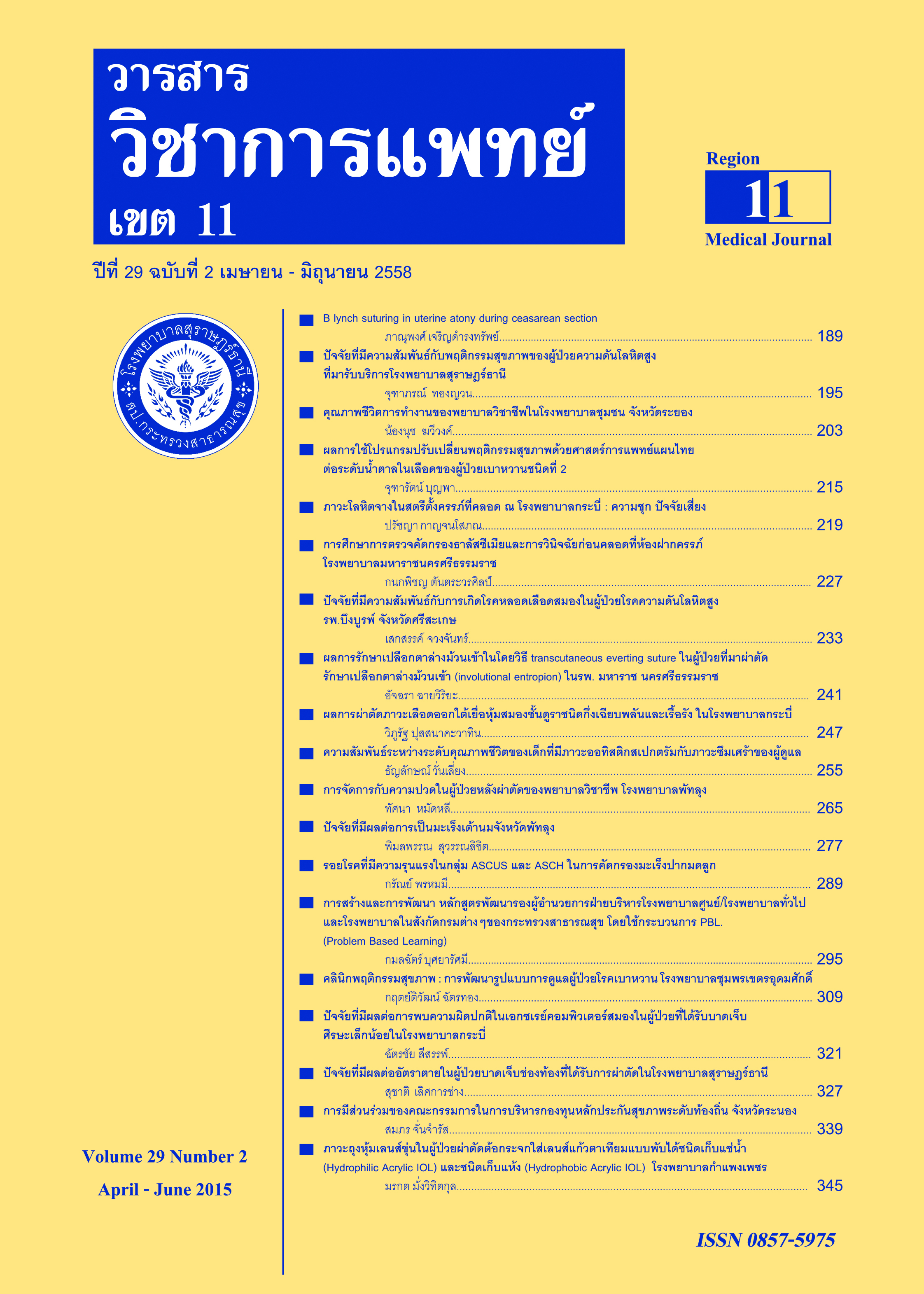B lynch suturing in uterine atony during ceasarean section
Keywords:
Postoperative postpartum, B-Lynch sutureAbstract
Objective B Lynch suture in uterine atony prophylaxis postpartum hemorrhage during ceasarean section.
Method A Descriptive study, April 2013 – May 2014 was controlled at Suratthani hospital Thailand. During that period there were 7500 deliveries with a ceasarean section rate of 45% (3375). Our of those 3375 ceasarean section the first author had performed 600 (17%), 50(8.3%) of which needed B-Lynch suture to control the uterine atony.
Results Total 50 cases , 47 cases successful for prevention of uterine atony. 3 cases had postoperative postpartum hemorrhage (2 cases from placenta previa,1 case from eclampsia) and need PRC methegin, nalador, cytotec for resuscitation.No case needed reoperation from postpartum hemorrhage and none require a hysterectomy.
Conclusion B-Lynch technique is a safe, effective, easily and prevention implemented method of postpartum hemorrhage due to uterine atony during ceasarean section.
References
2. Hayman R, Arulkumaran S, Steer P. Uterine compression sutures: surgical management of postpartum hemorrhage.ObstetGynecol 2002; 99:502–6.
3. Stones R,PatersonC,Saunders N. Risk factors for major obstetric haemorrhage. European Journal of Obstetrics,Gynecology and Reproductive Biology 1993:48:15-8.
4. B-Lynch C, Coker A, Lawal A, Abu J, Cowen M. The B-Lynch surgical technique for the control of massive postpartum hemorrhage: an alternative to hysterectomy? Five cases reported. Br J ObstetGynaecol 1997;104:372–5
5. B-Lynch C. B-Lynch brace suture (technical details). Available at : http://www.cblynch.com/ HTML/technique.html. Accessed September 25, 2003
6. Smith K, Baskett T. Uterine compression sutures as an alternative to hysterectomy for severe postpartum hemorrhage. J ObstetGynaecol Can 2003;25:197–200.
7. Mazhar S. Management of massive postpartum hemorrhage by “B-LYNCH” brace suture. J CollPhysSurg Pak 2003;13:51–2.
8. Wergeland H. Use of the B-Lynch suture technique in postpartum hemorrhage. Tidsskr Nor Laegeforen 2002;122:370–2.
9. Vangsgaard K. bB-Lynch sutureQ in uterine atony. UgeskrLaeger 2000;162:3468.
10. Ferguson J. B-Lynch suture for postpartum hemorrhage.ObstetGynecol 2000;95(6 Pt. 2): 1020 –2.
11. Dacus J. Surgical treatment of uterine atony employing theB-Lynch technique. J Matern-Fetal Med 2000;9:194– 6.
12. Danso D, Reginald P. Combined B-lynch suture with intrauterine balloon catheter triumphs over massive postpartum haemorrhage. Br J Obstet- Gynaecol 2002;109:963.
13. Steer P. Correspondence. Br J ObstetGynaecol 1999;106:286.
14. Roman A, Rebarber A. Seven ways to control postpartum haemorrhage. Contemp Obstet Gynecol 2003;48:34– 53.
15. Department of Health. Why mothers die: report onconfidential enquiries into maternal deaths in the UnitedKingdom 1997—1999. London, England7
RCOG press; 2001; 94– 103.
16. Royal College of Obstetricians and Gynaecologists. Placenta praevia: diagnosis and management. Guideline, vol. 27.London, England7 RCOG
Press; 2001.
17. Farrell E. Obstetric haemorrhage management guidelines.J Healthc Prof 2002;6:1 –7.






